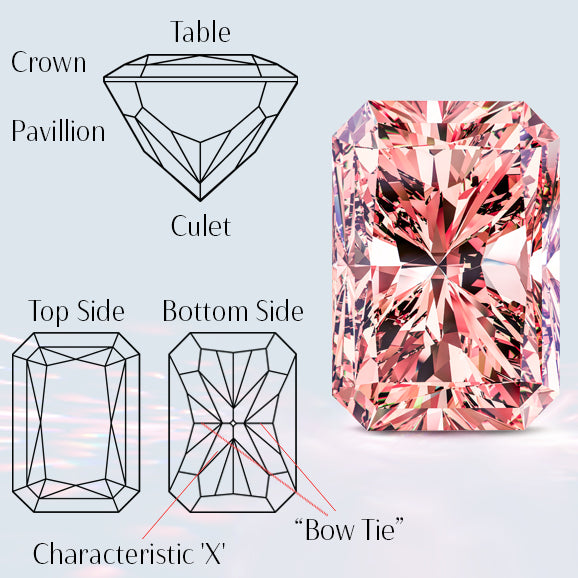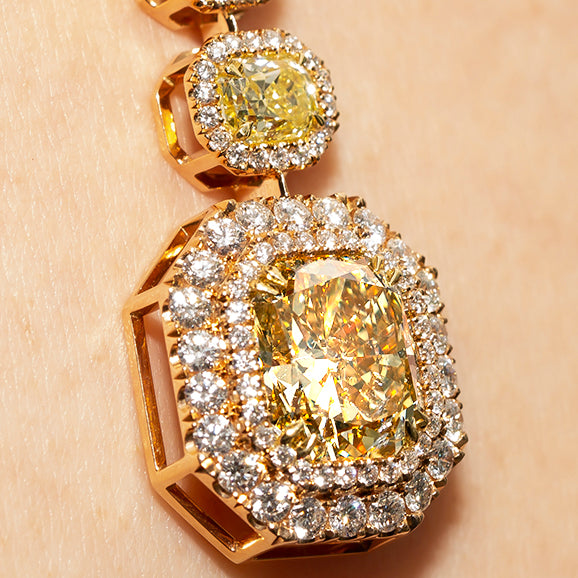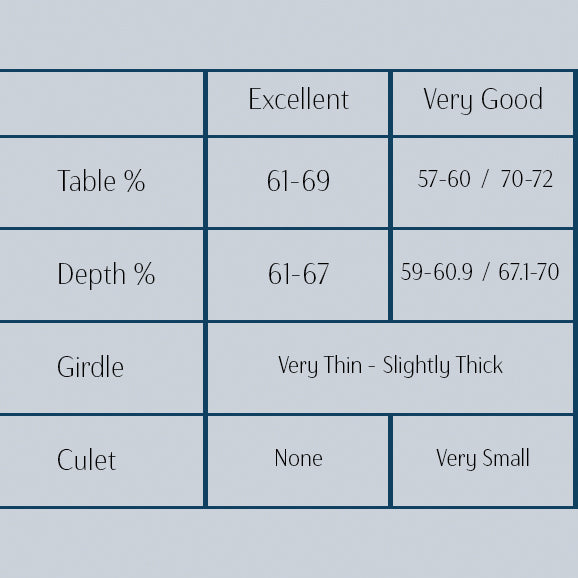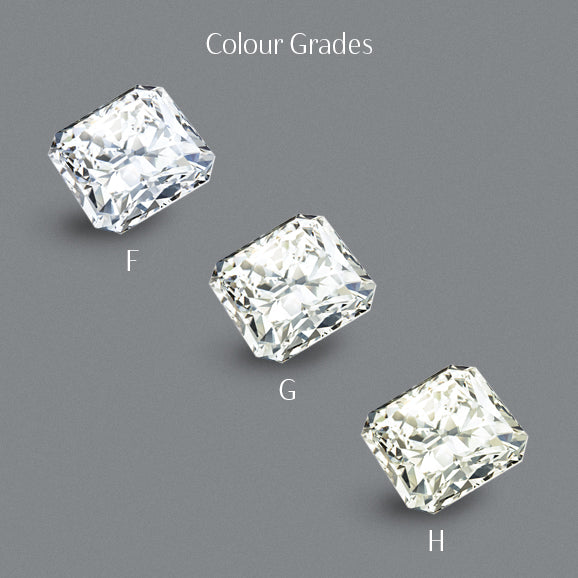
The radiant cut diamond is a rectangular, brilliant-cut diamond with 70 facets. The corners are bevelled, giving the diamond eight sides in total. Precision cutting of each facet provides this design with a degree of brilliance and fire that approaches the round brilliant cut.
The bevelled corners make radiant diamonds physically robust; they are resistant to both chipping and breakage.
Radiant cut diamonds are a new shape that was introduced in 1977 by Henry Grossbard. The shape combines the best of both emerald and round brilliant cuts in an elegant yet scintillating new way.
The shape, facets and proportions of radiant cut diamonds enhance the colour of diamonds, making the shape the right choice for buyers of fancy coloured diamonds.

What Should You Look For In A Radiant Cut Diamond?
A radiant shaped diamond has the elegant look of an emerald shaped diamond and most of the brilliance and sparkle of a round cut brilliant diamond.
When you choose a radiant cut diamond look for the characteristic 'x' extending out from the culet to the corners of the stone. There may be a bow-tie effect visible when looking downward at the stone. As with other diamonds that can show the effect, in small doses, the darker triangle pattern can add to the visual appeal of the stone. Too much bow-tie will always distract from the beauty of the gem and affect its value. The bow-tie effect is not part of the lab grading of a radiant cut diamond, making a personal visual inspection or checking with high-quality video or images a vital part of the purchase.
A well-cut radiant will have edges that run parallel to each other and cut corners that face one another exactly. The culet, the lower point of the diamond, should be equidistant from each corner.
In general, an excellent radiant diamond will feature good symmetry.
Most radiant cut stones will have 70 facets, but this can vary according to the cut and proportions of the gem.

Settings Should Let The Light Shine
The best settings for radiant cut diamonds are those that can allow light to enter the stone so that it can be reflected upward to the wearer and admirers.
Prong settings with a prong at each corner will give the best results. The corner prongs serve to protect the gem from chips and impacts while allowing a maximum amount of light into the diamond to make the most of all the sparkle locked into the stone by the cutter's expertise.
Halo settings can flatter smaller stones with perceived size enhancement that a surround of small diamonds gives to the centre stone. A larger diamond can stand for itself in a solitaire setting.
When you choose grade and clarity, the radiant cut can support your budget! The facets and sparkle conceal flaws that would be easily visible on an emerald-cut gem. The brightness tends to make even slightly yellow diamonds appear whiter than the grading report might suggest.

Cutting Guidelines For Radiant Cut Diamonds
The secret to a getting the best from a radiant diamond is the cutting. A good cutter can conceal flaws and enhance colours while maximising the brilliance of the stone.
When you choose a radiant cut diamond, there are some ratios and observations to check that will help to buy the best diamond within your budget. The following table provides a guideline to use when evaluating a possible purchase.
Radiant Cut Diamond - Cut Guide And Proportions
Click Here For Full Proportions
A radiant cut diamond can be rectangular or square; the proportions are a matter of preference for the buyer. A ratio of 1.05 will look perfectly square, but a stone that is only slightly rectangular can look 'off' as though a cutting error had been made. For this reason, choose rectangular stones with a ratio of greater than 1.08. At the same time, too thin a rectangle is not a good choice so look for stones with a ratio less than 1.30.
The golden rule is that if the proportions of a stone look right for you, then it is the right choice.

Suggested Clarity And Colour For A Radiant Diamond
Radiant Diamond Clarity Grades
The large table facet (the top facet) held in common with the emerald shape makes the radiant cut diamond good at revealing inclusions. To buy a diamond that is unlikely to have visible inclusions look to diamonds with a clarity grade of at least VS2. Before making your final choice ensure that your diamond is eye clean by checking it from above in good light. A lower graded diamond might be acceptable, depending upon the location of the inclusions.

Radiant Diamond Colour Grades
Radiant cut diamonds do not have the sparkle and brilliance of round-cut diamonds; as a result, they reveal colour shading more easily than round diamonds. This characteristic is an advantage when buying a fancy coloured diamond, but when choosing a white gem, yellowing is more easily seen.
If you want a very white looking stone, then choose a diamond graded at G or better. Larger diamonds, over 2 carats would be better with an F graded gem, or better. A white metal setting will enhance the perceived whiteness whatever grade is chosen.If a yellow tint is preferred, then the lesser colour graded will work very well, and a yellow metal setting will further enhance the warmth of the diamond.
Radiant cut diamonds are a great choice if you want to buy a fancy coloured diamond, the cutting style can enhance the colours making a spectacular piece of jewellery.
The relative lack of brightness compared with round cut diamonds means that choosing the grade of colour and clarity is essential but, if your budget is tight, a well-chosen diamond can allow you to economise on the clarity with a good saving.
A rectangular radiant cut can, similarly to other elongated shapes, flatter the wearer's fingers, making them look longer and slenderer.
The shape and robustness of the cut enable you to choose from a wide variety of settings as you are freed from concerns about the physical safety of the gem.
Overall, radiant cut diamonds offer a brilliant alternative to the more conventional emerald cut.